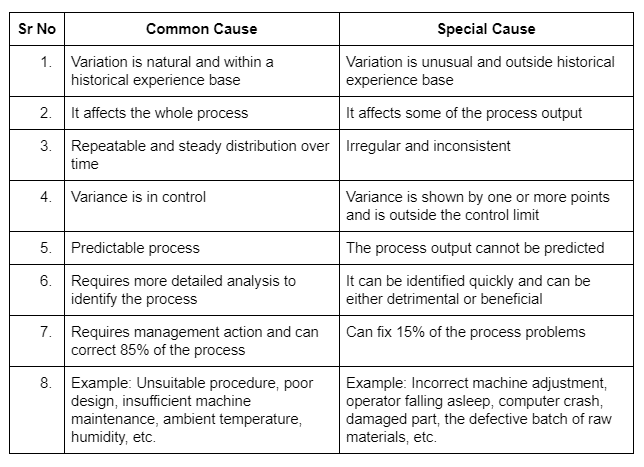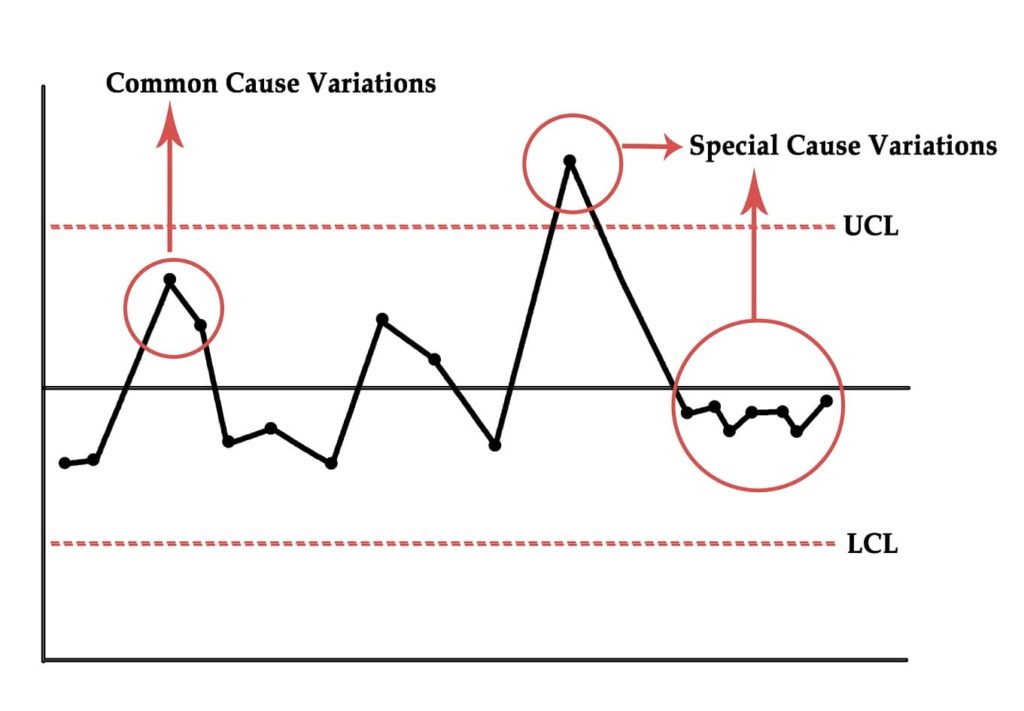Special Cause Variation is Always Easy to Detect.
Processes always have variations, which can be common cause or special cause variations.
The factors that cause variances in project performance are:
- Changes in project scope.
- Lack of resources.
- Wrong estimates.
- Incorrect identification of scheduled activities.
- Wrong project reviews.
- Poorly implemented project management processes.
- Poor risk review.
- Inefficient change control procedures.
- Modifications in the regulatory framework.
- Maturing business needs.
- Modifications to end-user requirements.
- Changes in market conditions.
Successful project management is about managing these critical performance transitions.
The variance shows how data is distributed. A zero variance indicates results are identical – an uncommon condition. When variation shows conflicts, the data points on the charts are spread out. In a minor variation, the data points are closer. Variance is always nonnegative.
It refers to the measurement for a group of numbers that spread out from their average value. We use variation in statistics, quality management, genetics, and biology.
Types of Variance
Dealing with variation is challenging because, many times, you don't know if you should act. Also, adjusting every variation is a never-ending process. Dr. Deming called this "tempering the process."
Instead of enhancing the quality, tempering reduces the quality. You must avoid tempering.
The causes of variation can be categorized as below:
- Common Cause Variation, e.g., cough, cold, malaria, etc.
- Special Cause Variation, e.g. (reason for causes): COVID!
Common Cause Variation
These variations consistently operate on the process and produce a strong and repeatable distribution over time.
Variance is a part of the process, and you cannot control it. According to Harry Alpert in 1947, common cause variations are referred to as natural problems. Specific actions cannot be implemented to prevent this variance or failure.
The characteristics of common causes variation are:
- Variation predictable probabilistically.
- Phenomena engaged within the system.
- Historical experience base variation, which is not regular.
- Lack of significance in individual high and low values.
This variation lies within three standard deviations from the mean, where you can find 99.73% of expected values. A few random points indicate them on the control chart within the control limit. These variations will require management action since there can be no quick rectification process.
A fundamental change is necessary to reduce the number of common causes of variation. If the chart has only common causes of variation, the process is "statistically stable."
Benefits of Common Cause Variation
The benefits of finding the common cause of variation are given below.
The Process Consequence is Predictable in the Short Term
When data points are in limits, the process has no variation.
Assess Process Capability
A process is deemed competent if it is stable and the common cause variation is within the specification boundaries and centered on the target.
Improve the Process
If measuring the process is tricky, you can shrink its variation by driving fundamental changes to its vital process components.
For example, an experiment showed specific machine settings could diminish the common cause variation of the process measure.
Common Cause Variation Examples
You estimated ten days to complete a hotel construction project. Due to the climatic conditions, the work was completed in 11 days.
Since the task duration had not deviated too extensively from the mean, the above example states common cause variation.
Below are examples of the common cause of variance within a project.
- Vague scope definition
- Insufficient design
- Inadequate management
- Incomplete procedures
- Weather conditions
- Temperature
- Humidity
- Computer response time
- Inadequate working conditions
Special Cause Variation
Special cause variations affect some part of the process output. They are often intermittent and unexpected.
Special cause variation refers to unanticipated glitches that drastically affect a process. The term special cause variation was created by W. Edwards Deming. It is understood as an "assignable cause."
Special cause variation is not part of your everyday process and occurs randomly. Causes are generally related to some system, process, or method deficiency. The failure can be corrected by changing the involved methods, components, or processes.
The features of special cause variation are:
- New and unanticipated episodes within the system.
- Variations of these types are usually unpredictable and problematic.
- The variation has never occurred before and is outside the experience base.
The points lie beyond the control limit on a control chart. Once identified on a chart, this problem must be handled instantly.
Special Cause Variation Example
Tom takes 10 minutes every day to reach work. Due to traffic, he took 20 minutes to reach the destination on a particular day.
Other examples are laptop malfunctions, crashes, a power cut, etc.
To assess a project's health, you track the difference between the original plan and the actual progress. The use of control charts helps differentiate between the common cause variation and the special cause variation, making changes and amendments easier.
Importance of Understanding Special Cause Variation
A control chart investigates if the variation requires attention. A special cause is assignable to a process component that has changed.
Investigating the special cause will:
- Advise when to act to adjust or improve the process.
- Equip data to recommend or evaluate a process improvement.
If special cause variation doesn't exist, the process is in control. Implementing process changes when a special cause is not present is called tampering and can boost the variation of the process and lower its quality.
Common Cause vs Special Cause Variation
Common cause variation is where a combination or no factors influence the process variation. Special cause variation is when one or more factors influence the process variation in a non-random way.

Common Cause vs Special Cause Charts
A control chart is a graphic presentation of data over time against control limits, with a centerline that assists in detecting a trend of plotted values.
Control charts show how processes are doing over time; they predict if the project is in control. A process is in control if the measurements are within the control limits.

The chart above shows that the data points fall beyond the mean. The process is well within the control limits. However, when the data points fall outside the control limits, remedial or corrective action must be taken to control the process.
How to Counter Variation
Once variances are identified, it is essential to counter them.
- Counter common cause variation by employing long-term process changes.
- Counter special cause variation by employing emergency plans.
For example:
- Fever due to cough, cold, and malaria. These are common cause variations.
- Product dissimilarities due to a shipment of defective metals. These are a special cause of variation.
Countering Common Cause Variation
To counter common cause variation, a change in behavior and process is required. A process change would surely benefit the organization in the long run.
Countering Special Cause Variation
To counter special cause variation, you need contingency plans. Implement these plans only when a special cause is present.
Conclusion
Standard and special causes are the two distinct origins of variation in a system. You must determine the type of variance in a process because the correction action depends on it. Using a control chart helps distinguish the common causes of variance and special causes of variance.
How do you manage variance in your projects? Please share your thoughts through the comments section.
Source: https://pmstudycircle.com/common-cause-vs-special-cause-variations/
0 Response to "Special Cause Variation is Always Easy to Detect."
Post a Comment